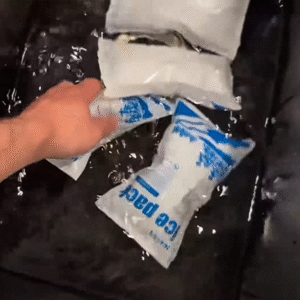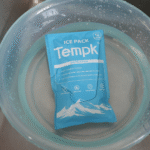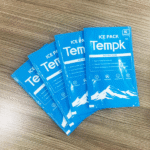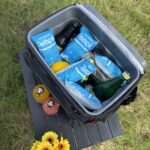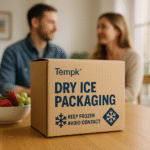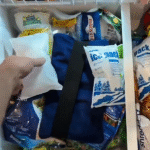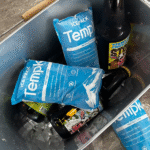Next Day Dry Ice Pack: How Do You Ship Frozen Goods?
UN next day dry ice pack keeps your frozen items solid through the fastest leg of your cold chain. You need the right box, the right dose, and a plan for safe venting. Dry ice sits at −78.5 °C and buys you a 24–36 hour window when sized well. Dans ce guide, you will learn simple steps that work in the real world, not just in a lab.
-
Combien next day dry ice pack you actually need for typical weights
-
Which packaging choices extend hold time with related long‑tail keywords
-
How to comply with carrier and safety rules without slowing fulfillment
-
Ways to cut cost and emissions using hybrid packouts and route planning
What is a next day dry ice pack and when should you use it?
Réponse directe
A next day dry ice pack is a shipper and dry ice load sized to hold a frozen state for one calendar day, from pickup to delivery. Use it when products must arrive hard‑frozen and shipping lanes can deliver in under 36 heures. It suits frozen meals, premium meats, and time‑critical biotech items. Typical packs use ventilated outer boxes and rigid foam or vacuum panels.
Explication élargie
You choose a next day dry ice pack when speed beats buffer time. One day lanes lower risk and cost. The pack relies on sublimation: solid CO₂ turns to gas, absorbing heat like a sponge. You get steady cold without water mess. It shines for last‑mile air or regional ground with predictable cutoffs. Add a small data logger if you need proof. For fragile desserts or lab samples, line the inner walls and place dry ice above, ci-dessous, and around the payload to create even cold.
How much dry ice for next day delivery?
Détails
Start with a simple rule of thumb: more surface area means more heat gain. Denser payloads hold cold better. For a next day dry ice pack, many teams begin at 15–25% of payload weight in dry ice, then test. Increase the dose for hotter lanes, peak season, or porch dwell time. Decrease when you upgrade insulation or reduce voids.
| Type d'emballage | Poids de la charge utile | Dry Ice Load (start) | What It Means For You |
|---|---|---|---|
| Frozen entrées shipper | 1–2 kg | 1–2 kg | Keeps a solid freeze overnight; compact box reduces shipping zone costs |
| Premium proteins shipper | ~5 kg | 4–5 kg | Balances hold time with porch buffer; good for warm climates |
| Research samples shipper | ~10 kg | 8–10kg | Extra margin for handoffs, delays, or tarmac heat |
| Dense desserts shipper | 3–4 kg | 2–3 kg | High sugar/fat density slows thaw; you can use less dry ice |
| PCM hybride + glace carbonique | 4–6 kg | 1–2 kg + PCM | PCMs blunt heat spikes; dry ice maintains freeze core |
Conseils pratiques et gains rapides
-
Tarmac risk: Load extra dry ice in summer. Aircraft holds can run warm during turns.
-
Top‑loading: Keep some dry ice above the payload. Cold gas falls and blankets the product.
-
Tight voids: Fill gaps with liners or crumpled kraft. Less air equals less heat.
-
Porch buffer: Add 1–2 kg extra for delivery windows that slip past noon.
-
Data check: Toss in a basic logger. One run pays for itself by cutting guesswork.
Cas réel: A regional meal brand switched to a 6‑liter foam shipper, moved dry ice above and below product, and trimmed failed deliveries by two‑thirds during a July heat wave while reducing complaints on texture.
Which packaging for a next day dry ice pack works best?
Réponse directe
Choose thick insulation, a ventilated outer carton, and a leak‑proof liner for the next day dry ice pack. For most SKUs, a 25–38 mm rigid foam box or a hybrid vacuum panel system works. Use inner bags to prevent freezer burn and odor transfer. Label for carbon dioxide, solide, and ensure vent paths are not blocked.
Explication élargie
Box size matters. Oversized boxes invite heat. Right‑size the cube so dry ice touches or wraps the payload. If you can upgrade insulation by one step, you often cut dry ice by 10–20% in the same lane. Vacuum insulated panels (VIP) save weight at a cost premium. Use them for high‑value or temperature‑sensitive items. Add a corrugated outer for crush strength and to hold the required UN1845 markings.
Insulation thickness cheat‑sheet for next day lanes
Détails
Use this chart as a starting point. Test your own lanes and seasonality.
| Climat / voie | Isolation | Add‑Ons | What It Means For You |
|---|---|---|---|
| Mild spring, overnight air | 25 mm EPS | Poly liner | Lowest cost path for light foods |
| Hot summer, cross‑country | 38 mm EPS or 25 mm VIP | Reflective pouch | Cuts dry ice load and porch risk |
| Extreme heat or porch dwell >4 H | 25 mm VIP + 12 mm EPS overwrap | Gel‑liner to stop frost | Highest protection, lower mass |
| Cold winter lanes | 25 mm EPS | Minimal extras | Reduce dry ice to avoid over‑hardening sensitive items |
“Fit the box” technique for next day dry ice pack
-
Measure the product stack height without headspace.
-
Pick the smallest inner cube that allows top and bottom dry ice layers.
-
Keep wall clearance to 10–15 mm per side when using pellets.
-
Use a rigid sleeve or dividers to stop shifting in transit.
How do you comply with rules for a next day dry ice pack?
Réponse directe
Mark shipments as “Carbon dioxide, solid” with proper UN1845 labels, provide ventilation, and record net dry ice weight. Ne jamais sceller les évents. Use carriers’ instructions for air transport, and ensure staff wear gloves and eye protection when handling dry ice.
Explication élargie
Dry ice releases CO₂ gas. You must allow it to vent so pressure does not build. Carriers require visible labels and a clear net weight of dry ice on the package. For aircraft, follow the current packing instructions for CO₂, solide, including limits per package and per compartment. On the warehouse floor, store dry ice in open, cool spaces, not in sealed rooms. Train teams on frostbite risk and safe disposal.
Simple shipping checklist (copier / coller)
-
Box is ventilé, pas hermétique
-
UN1845 et «Dioxyde de carbone, solide" label applied
-
Poids net de glace carbonique written clearly on exterior
-
Gloves and eye protection available at packout
-
No glass bottles or sealed containers that can burst
-
Courier booked on du jour au lendemain service with early dropoff
-
Porch dwell buffer added to dose in peak season
How do you size a next day dry ice pack with a calculator?
Réponse directe
Estimate heat load from the box and your lane, then pick a dry ice dose that covers 24–36 hours with a small buffer. You can model this with a simple formula that considers surface area, insulation value, and ambient conditions.
Explication élargie
Think of heat trying to sneak through your box. Insulation slows it. Your job is to buy enough cooling power to cancel that heat for a day. Dry ice absorbs a lot of heat as it sublimates. The math can get complex, but a practical model gets you within 10–20% fast. Test a few packouts and tune the dose.
Sizing example you can adapt
-
Foam shipper external area: 0.35 m²
-
U‑value estimate: 0.7 W/m²·K
-
ΔT: 30 K (hot day vs frozen interior)
-
Time: 30 H (pickup to delivery + tampon)
-
Q ≈ 0.7 × 0.35 × 30 × (30 h × 3600 s) ÷ 1000 ≈ 793 kJ
-
Dry ice ≈ 793 / 571 ≈ 1.4 kg → round to 2 kg for buffer
Conseil: Log one box per lane for a week. You will find 10–15% savings by tuning dose to the hottest part of the route.
How do you pack a next day dry ice pack step‑by‑step?
Réponse directe
Préchauffeur, layer dry ice around the payload, seal liners, and leave clear vents. Étiquette, weigh, and hand to the carrier on an early truck.
Explication élargie
Cold starts cold. Freeze products hard. Pre‑chill the shipper if possible. Add a thin bottom layer of dry ice. Place the product in the center. Surround with pellets or slabs. Add a top layer. Close the inner liner. Tape the outer carton loosely over vent holes. Write the net dry ice weight, then apply the hazard label.
Packout flow for the floor
-
Pre‑chill products and shippers
-
Bottom dry ice layer
-
Charge utile + side fill
-
Top dry ice layer
-
Inner liner closed, not vacuum tight
-
Apply labels and record net weight
-
Stage for the first outbound truck
Cut cost and emissions with a next day dry ice pack
Réponse directe
Reduce cube, upgrade insulation only where it pays back, and try hybrid PCM + dry ice to lower CO₂ use. Consolidate orders and choose early deliveries to slash porch risk without extra ice.
Explication élargie
Transport cost is a cube and weight game. Smaller boxes save on every lane. A modest insulation upgrade often cuts ice by more than the added box cost. Matériaux de phase de phase (PCMS) soak up short spikes near 0 °C. In a frozen application, they can stabilize edges while dry ice handles the heavy lifting. Shave grams from tape, étiquettes, et remplissage vide. Every gram matters over thousands of boxes.
Quick ROI levers
-
Right‑sizing: Move to the next smaller cube; target <15% headspace
-
Insulation swap: 25 mm EPS → 25 mm VIP on hot lanes only
-
Hybrid core: Add PCM tiles near door‑facing sides
-
Route shift: Use morning delivery windows where available
-
Order batching: Combine two weekly orders into one larger box
Quality control for a next day dry ice pack
Réponse directe
Use “golden sample” boxes, simple loggers, and pass/fail charts. Keep it visual and fast so packers do it every time.
Explication élargie
Create one master packout per SKU and lane. Photograph the steps. Tape those photos above the station. Require a quick sticker for net ice weight. Pull one box per pallet for a data logger. Build a three‑color chart: pass, watch, fail. Keep the feedback loop short so the team adjusts dose the same day.
Station checklist
-
Golden sample photo sheet posted
-
Net dry ice sticker filled in
-
Logger serial numbers recorded
-
Random open‑box inspection each hour
-
Exceptions escalated to shipping lead
Risk management for a next day dry ice pack
Réponse directe
Plan for delays, porch time, and hot handoffs. Add buffers only where they matter.
Explication élargie
Most failures happen at the edges: missed pickups, last‑mile delays, and porch sits. Buffer around those edges. Drop off earlier. Add 1–2 kg ice only for desert or heat‑wave lanes. Put a friendly “freeze on arrival” card in the box. Include a phone number for issues. Small touches reduce refunds.
“What could go wrong?” map
-
Missed pickup: Shift packout to earlier dock slot
-
Porch sit: Add SMS alerts to customers
-
Tarmac bake: Extra top layer in summer only
-
Wrong box used: Color‑code cartons by SKU
2025 trends in next day dry ice pack solutions
Aperçu de la tendance
Dans 2025, le next day dry ice pack is getting smarter and lighter. Expect wider use of low‑mass VIP panels, drop‑in IoT loggers with QR‑based sharing, and hybrid PCM cores that reduce CO₂ consumption. Carriers roll out greener lanes and carbon dashboards. Retailers push reusable totes on short routes. The winners test often and keep playbooks live.
What’s new at a glance
-
Hybrid cooling kits: PCM tiles paired with modest dry ice dose to smooth spikes
-
Edge analytics: Tiny loggers with phone‑scan graphs for instant proof of cold chain
-
Slimmer VIPs: Affordable panels that fit standard corrugate without custom tooling
Insistance au marché
E‑grocery and DTC proteins keep driving frozen volume on overnight lanes. Brands lean on regional fulfillment to shorten routes and cut dose. Customers reward “pack light” efforts, especially when boxes open cleanly. Expect more porch‑safe packaging and delivery window controls to reduce surprises and refunds.
Questions fréquemment posées
Q1: How long will a next day dry ice pack keep items frozen?
Most setups hold 24–36 hours when sized and vented well. Add buffer for hot seasons or long porches. Log the first runs and trim or add ice from there.
Q2: Can I use gel packs instead of a next day dry ice pack?
Gel packs keep items cold, not hard‑frozen. Use them for chilled foods. Pour les produits surgelés, stick with a next day dry ice pack or a hybrid with both.
Q3: How should I dispose of remaining dry ice?
Laissez-le sublimer dans une zone ventilée, away from people and pets. Never put dry ice in a sink, sealed bin, or walk‑in cooler.
Q4: Is a next day dry ice pack allowed by all carriers?
Oui, with proper labels, weight markings, and vents. Some carriers limit dry ice mass per package or per compartment. Check current rules before peak season.
Q5: What size pellets or slabs should I pick?
Pellets fill gaps and cool fast. Slabs last longer and resist tarmac heat. Many teams use a slab on top and pellets around the sides.
Q6: Will a next day dry ice pack damage packaging?
It can if materials are brittle or the box is airtight. Use vent paths and liners, and avoid thin plastics that crack when cold.
Q7: Can I ship glass bottles with a next day dry ice pack?
Avoid sealed glass that can build pressure. If you must, use pressure‑rated caps, sleeves, and vents, and follow carrier guidance.
Q8: How do I prevent freezer burn inside the next day dry ice pack?
Wrap products in moisture‑safe film, remove headspace in inner bags, and keep air movement down with tight void fill.
Résumé et recommandations
Principaux à retenir
UN next day dry ice pack protects frozen products across a one‑day lane when you right‑size the cube, layer ice above and below, and leave vents clear. Upgrade insulation only where it pays back. Use a simple model and a data logger to tune the dose. Label everything and train your team.
Plan d'action
-
Map your hottest lanes and porch windows.
-
Build two test packouts per SKU.
-
Log five boxes, then adjust dose by 10–20%.
-
Add hybrid PCM where porch time is common.
-
Roll out a golden sample and QC chart.
CTA: Need a ready‑to‑ship kit? Talk to our team about standard and custom next day dry ice pack solutions.
À propos du tempk
Qui nous sommes
We are a cold‑chain solutions company focused on simple, tested answers for frozen and chilled shipping. Our kits combine right‑sized boxes, isolation fiable, and easy labels. We back them with playbooks and fast support. Customers use fewer materials and see fewer returns.
Que faire ensuite
Reach out for a lane review and a quick packout test. We will size a next day dry ice pack that fits your product and your budget.






